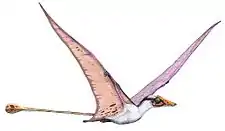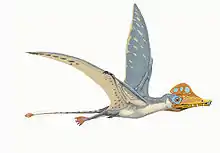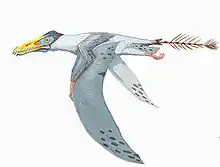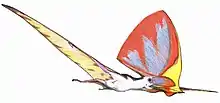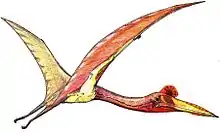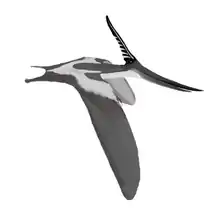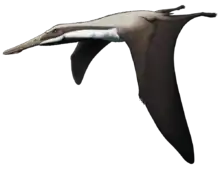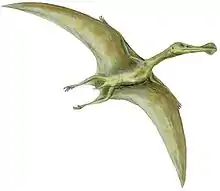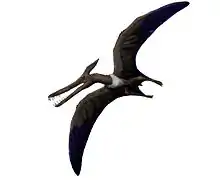Lacusovagus
Lacusovagus (meaning "lake wanderer") is a genus of azhdarchoid pterodactyloid pterosaur from the Lower Cretaceous of Brazil. It is based on SMNK PAL 4325, a partial upper jaw comprising sections of the skull in front of the eyes. This specimen was found in rocks of the Early Cretaceous-age (probably Aptian stage, about 120 million years ago) Nova Olinda Member of the Crato Formation. The skull was long, and unusually wide. The section in front of the combined nasal-antorbital fenestra was relatively short. Also unusual was the combination of its toothless jaws and no bony head crest. Lacusovagus was described in 2008 by Mark Witton. The type species is L. magnificens, meaning "grand lake wanderer", in reference to its large size—it is currently the largest pterosaur known from the Crato Formation with an estimated wingspan of 4.1 meters (13 feet).[1]
| Lacusovagus | |
|---|---|
 | |
| Holotype specimen | |
| Scientific classification | |
| Kingdom: | Animalia |
| Phylum: | Chordata |
| Order: | †Pterosauria |
| Suborder: | †Pterodactyloidea |
| Clade: | †Ornithocheiroidea |
| Clade: | †Azhdarchoidea |
| Genus: | †Lacusovagus Witton, 2008 |
| Species: | †L. magnificens |
| Binomial name | |
| †Lacusovagus magnificens Witton, 2008 | |
Lacusovagus shares many characteristics with the basal azhdarchoid family Chaoyangopteridae, and preliminary studies suggested it was a member of that clade.[1] However, in 2017, a phylogenetic analysis found it to be within the genus Tupuxuara, a member of the Thalassodromidae.[2]
References
- Witton, Mark P. (2008). "A new azhdarchoid pterosaur from the Crato Formation (Lower Cretaceous, Aptian?) of Brazil". Palaeontology. 51 (6): 1289–1300. doi:10.1111/j.1475-4983.2008.00811.x.
- Wu, W.-H.; Zhou, C.-F.; Andres, B. (2017). "The toothless pterosaur Jidapterus edentus (Pterodactyloidea: Azhdarchoidea) from the Early Cretaceous Jehol Biota and its paleoecological implications". PLoS ONE. 12 (9): e0185486. doi:10.1371/journal.pone.0185486. PMC 5614613. PMID 28950013.
